Business Card Evolution: From Card to Application
What could be simpler than a business card - a standard contact card? Meanwhile, this is perhaps the most tenacious element of business turnover. Letters and merchants were replaced by invoices and acts, collars and arm ruffles became extinct, invoices were gathering dust on the balcony, the fax machine got the last time and disappeared, there were almost no diskettes, now the CD was almost a thing of the past, even the unshakable and eternal e-mail made way near messengers. Business cards are more alive than all living ones - they are already more than 600 years old, and they exist as if nothing had happened. But evolution has not bypassed this way of storing and transmitting data: LCD screens, scanners, QR codes, applications. However, cardboard rectangles started and still wins. Or not?

Frankly, when we created our application for creating electronic business cards MyQRcards , we did not think about the fact that cards have such an amazing story with a length of more than half a millennium. When they started, they became interested, understood that it was a whole culture. And, as stated in our favorite cartoon, we want to tell the world about it. Habr and the world.
Like many great things (we are not talking about Xiaomi, if that), the first business cards left their mark on history in China. There they appeared in the 15th century: Chinese merchants and wealthy "entrepreneurs" used special cards to indicate their intention to meet with another person. It happened that the servants collected cards from potential visitors, and traders and nobles looked through the cards to identify and identify who they were ready to meet.
Business cards in the form in which we are used to seeing them appeared in the 17th century in Europe. They were used to notify the arrival of people of high descent in a city or a particular house. At that time, the size of the business card was about the usual playing card for us.
By the 19th century, business cards ceased to be a privilege of the upper class and became available and even mandatory for the middle class. At the same time, design also evolved: ornate fonts, gold and silver stamping came into fashion, special boxes for business cards appeared, in which you had to put a card when visiting the house. On the cards was located not only the basic information about the person, but often the advertisement and the owner’s biography.
Business cards were overgrown with traditions and were not just a formality, but also a whole informational message. For example, cards with bent corners were intended to be transferred from a specific person to a specific person, and cards folded in half indicated that the data could be accessible to all family members. Sometimes special parameters were indicated, for example, P / F for a congratulatory visit, P / C for expressing condolences.
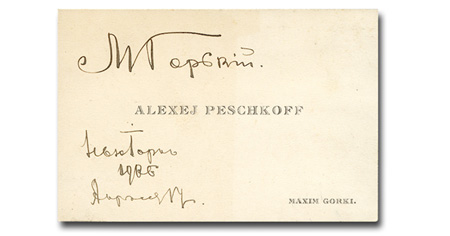
Business card of Maxim Gorky
The fate of business cards was changed by the industrial revolution.
In the XIX century, business cards reached their peak: they were embossed, cotton, engraved on thin metal, etc. But color lithography, the heritage of the Victorian era, made them a real work of art. Such cards were not just a carrier of personal information, but also a collectible. It was then that business cards gained their permanent function - they became an advertising medium. Business owners quickly realized that they were striving to make cards truly unique, thereby increasing the likelihood that the card will be saved and will constantly remind you of a product or service. The printers were not taken aback: they printed template cards with basic drawings, and the owner himself could add his useful or advertising information.

Stone lithopress - business cards were printed on this in the 19th century
There are fewer formalities and curtsies, but more capitalism. The exchange of contact information has become part of the business turnover, and in this form, has moved to the XX, and then to the XXI century.
Today, business cards are saved as a look, but they are not saved in our pockets at all - it even happens that when you come from a conference or a big meeting, you want to collect everything, but you can’t: some fell out, some were rubbed, some were sweated along with body parts. Well, it’s not the case.
The most interesting thing is that rodexes are still sold in the USA and Europe, and in 2015 there was a spontaneous boom in demand for such "business card holders", and Chinese online stores established their sales. But as they say, it's not that.

Rolodex, real, with a box - we ourselves would not refuse such a rarity
Naturally, the ubiquitous IT specialists and engineers did not ignore such a developed industry, which literally asked for automation itself: fields, unified data, storage and processing, the need for sorting - what else do you need from the requirements to create something innovative?
And this story of innovation partly consisted of fakaps.
The most unfortunate innovation was business cards with displays on which you can change information - too hard, expensive, difficult. And the design turned out to be demanding on electricity.
An example of LCD business cards is the Halo project, a 2011 startup. The front side of the business cards was a touch display. On board the mini-gadget was a processor, memory and a small battery. Of course, such a business card was a pity and expensive to give an opponent. Yes and no need. The meaning of the work was different: the data exchange between the devices of the two Halo owners was carried out via the Bluetooth protocol, and the transmitted business cards were stored on a memory card (by the way, this was not a module, but a regular microSD). Halo cards had quite a presentable and concise interface, the search for the necessary contacts was carried out with a few touches.

Business cards of the Halo project - startup 2011-2012
The market was not very popular with numerous attempts to create the world's best business card scanner. One of the first notable devices was the B-scanner, released in 2008. The gadget had the size of a regular business card (slightly larger in frame) and simply scanned each card handed in, saving the result in an image format. The user could sort business cards at his discretion and view them directly on the scanner's OLED display. At that time, everything was lame: logic, interface, ergonomics and, of course, the quality of the display itself.
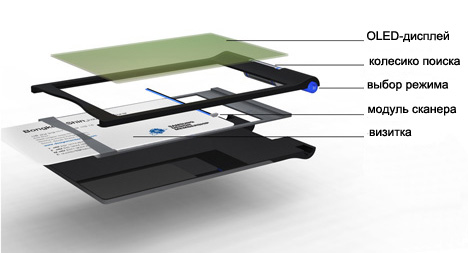
Source Digital Business Card Storage: B-scanner Concept
In mid-2011, business card scanners returned: Sanwa Supply Corporation released a USB-gadget for scanning Business Card Scanner 400-SCN005 business cards. In fact, it was an external device for scanning cards and moving them to a PC. The scanner had a driver, support for 22 languages, a graphical user interface (GUI on a PC). Data was downloaded in image and text format and could be exported to table editors.
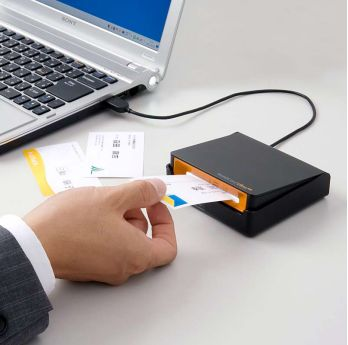
Business Card Scanner 400-SCN005
The beginning of the 2010s was marked by a surge of interest in the design of classic paper business cards. To stand out, users chose options in the form of objects, with some interactive moments (such as “insert 4 fingers - get paws”). In the video you can see how endless the fantasy of designers turned out to be.
You can find hundreds of such videos and posts - carefully, sticking is possible
The greatest interest in the mid-2010s was caused by laconic animated business cards: to make the image move, just pull on the inner cardboard. Everything ingenious is simple: interactive, simplicity, visualization, gamification came together in one elegant solution.
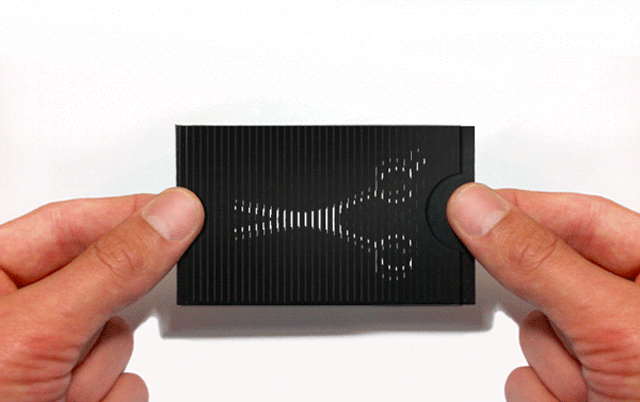
Technologies did not stop and in 2012 one of the first options appeared that was really successful and quite economical for its level of business cards. The manufacturing company Moo issued business cards with NFC sensors. The owner of such cards uploaded the information he needed (not only contacts, but also presentations, text, promos, music, video, etc.) and transferred it to the interlocutor with one touch on the smartphone. By the way, the project was successful - Moo still releases them. The NFC programmable chip fires when connected to a compatible iPhone (iOS 11 required) or Android device.

One of the first copies of Moo cards
The next successful solution was a QR code. QR was scanned by the gadget and led to the desired page of the site or person. QR business cards are not only widespread so far, but are also widely used in business presentations, videos, at exhibition stands, in applications, bots, etc. It was not by chance that we chose just such a technology. QR code today is a technological, universal and widely used way of transmitting information. It is used in business (for example, VKontakte, conducting presentations for clients, uses QR directly on slides so that students in the hall can open the necessary sections and pages of individual personalities directly on their mobile), soon QR will be used by Sberbank customers to pay for purchases, and already Now many of us scan QR codes to get information about discounts in a restaurant, read about a monument in a foreign city, go to the company’s website, etc.
When we created the MyQRcards service, we had our own motives, inspired by dozens of conferences and hundreds of contacts. In three words, we were uncomfortable.
Here are the situations that almost everyone has encountered:
So, we need to solve three important tasks: relevance, updatability on the fly and availability anywhere and anytime. But it seemed to us not so interesting, and since we started the development, we decided to make an application with a bunch of useful features. Eventually:
So what did we get?
In the end, we created a mobile application for iOS and Android . It is simple and intuitive.
A few screenshots - but it's better to download and test it yourself.




And I really liked it - MyQRcards are chosen because of its simplicity, convenience, speed of updating information and the ability to add some corporate chips.
Now the development of business cards has been most influenced by mobile technology. And the strategy is clear: the best business card is one that is always on your mobile phone and can be fixed simply and quickly. In the end, we forget mobile phones much less often than business card holders.
Do you think evolution will stop there?

Frankly, when we created our application for creating electronic business cards MyQRcards , we did not think about the fact that cards have such an amazing story with a length of more than half a millennium. When they started, they became interested, understood that it was a whole culture. And, as stated in our favorite cartoon, we want to tell the world about it. Habr and the world.
History of business cards: the beginning
Like many great things (we are not talking about Xiaomi, if that), the first business cards left their mark on history in China. There they appeared in the 15th century: Chinese merchants and wealthy "entrepreneurs" used special cards to indicate their intention to meet with another person. It happened that the servants collected cards from potential visitors, and traders and nobles looked through the cards to identify and identify who they were ready to meet.
Business cards in the form in which we are used to seeing them appeared in the 17th century in Europe. They were used to notify the arrival of people of high descent in a city or a particular house. At that time, the size of the business card was about the usual playing card for us.
By the 19th century, business cards ceased to be a privilege of the upper class and became available and even mandatory for the middle class. At the same time, design also evolved: ornate fonts, gold and silver stamping came into fashion, special boxes for business cards appeared, in which you had to put a card when visiting the house. On the cards was located not only the basic information about the person, but often the advertisement and the owner’s biography.
Business cards were overgrown with traditions and were not just a formality, but also a whole informational message. For example, cards with bent corners were intended to be transferred from a specific person to a specific person, and cards folded in half indicated that the data could be accessible to all family members. Sometimes special parameters were indicated, for example, P / F for a congratulatory visit, P / C for expressing condolences.

Business card of Maxim Gorky
The fate of business cards was changed by the industrial revolution.
In the XIX century, business cards reached their peak: they were embossed, cotton, engraved on thin metal, etc. But color lithography, the heritage of the Victorian era, made them a real work of art. Such cards were not just a carrier of personal information, but also a collectible. It was then that business cards gained their permanent function - they became an advertising medium. Business owners quickly realized that they were striving to make cards truly unique, thereby increasing the likelihood that the card will be saved and will constantly remind you of a product or service. The printers were not taken aback: they printed template cards with basic drawings, and the owner himself could add his useful or advertising information.

Stone lithopress - business cards were printed on this in the 19th century
There are fewer formalities and curtsies, but more capitalism. The exchange of contact information has become part of the business turnover, and in this form, has moved to the XX, and then to the XXI century.
Modernity: from cut paper to holograms and NFC
Today, business cards are saved as a look, but they are not saved in our pockets at all - it even happens that when you come from a conference or a big meeting, you want to collect everything, but you can’t: some fell out, some were rubbed, some were sweated along with body parts. Well, it’s not the case.
Cinema business cardsBy the way, in the 1970s a cult of boxing for storing business cards sorted in alphabetical order appeared: Rolodex is a rotating directory with cards used to store contact business information (the name comes from the English words rolling and index). But Rodex itself appeared much earlier - it was invented by Arnold Neustadter and Hildaur Neilson in 1956. For rolodeks (which became common nouns, like photocopiers) there was a format of cards. Someone considers Rolodex the prototype of the first CRM-systems.
In general, business cards have become a cult business symbol, which is reflected in many films. One of these is the American Psycho:
The most interesting thing is that rodexes are still sold in the USA and Europe, and in 2015 there was a spontaneous boom in demand for such "business card holders", and Chinese online stores established their sales. But as they say, it's not that.

Rolodex, real, with a box - we ourselves would not refuse such a rarity
Naturally, the ubiquitous IT specialists and engineers did not ignore such a developed industry, which literally asked for automation itself: fields, unified data, storage and processing, the need for sorting - what else do you need from the requirements to create something innovative?
And this story of innovation partly consisted of fakaps.
The most unfortunate innovation was business cards with displays on which you can change information - too hard, expensive, difficult. And the design turned out to be demanding on electricity.
An example of LCD business cards is the Halo project, a 2011 startup. The front side of the business cards was a touch display. On board the mini-gadget was a processor, memory and a small battery. Of course, such a business card was a pity and expensive to give an opponent. Yes and no need. The meaning of the work was different: the data exchange between the devices of the two Halo owners was carried out via the Bluetooth protocol, and the transmitted business cards were stored on a memory card (by the way, this was not a module, but a regular microSD). Halo cards had quite a presentable and concise interface, the search for the necessary contacts was carried out with a few touches.

Business cards of the Halo project - startup 2011-2012
The market was not very popular with numerous attempts to create the world's best business card scanner. One of the first notable devices was the B-scanner, released in 2008. The gadget had the size of a regular business card (slightly larger in frame) and simply scanned each card handed in, saving the result in an image format. The user could sort business cards at his discretion and view them directly on the scanner's OLED display. At that time, everything was lame: logic, interface, ergonomics and, of course, the quality of the display itself.

Source Digital Business Card Storage: B-scanner Concept
In mid-2011, business card scanners returned: Sanwa Supply Corporation released a USB-gadget for scanning Business Card Scanner 400-SCN005 business cards. In fact, it was an external device for scanning cards and moving them to a PC. The scanner had a driver, support for 22 languages, a graphical user interface (GUI on a PC). Data was downloaded in image and text format and could be exported to table editors.

Business Card Scanner 400-SCN005
The beginning of the 2010s was marked by a surge of interest in the design of classic paper business cards. To stand out, users chose options in the form of objects, with some interactive moments (such as “insert 4 fingers - get paws”). In the video you can see how endless the fantasy of designers turned out to be.
You can find hundreds of such videos and posts - carefully, sticking is possible
The greatest interest in the mid-2010s was caused by laconic animated business cards: to make the image move, just pull on the inner cardboard. Everything ingenious is simple: interactive, simplicity, visualization, gamification came together in one elegant solution.

Technologies did not stop and in 2012 one of the first options appeared that was really successful and quite economical for its level of business cards. The manufacturing company Moo issued business cards with NFC sensors. The owner of such cards uploaded the information he needed (not only contacts, but also presentations, text, promos, music, video, etc.) and transferred it to the interlocutor with one touch on the smartphone. By the way, the project was successful - Moo still releases them. The NFC programmable chip fires when connected to a compatible iPhone (iOS 11 required) or Android device.

One of the first copies of Moo cards
The next successful solution was a QR code. QR was scanned by the gadget and led to the desired page of the site or person. QR business cards are not only widespread so far, but are also widely used in business presentations, videos, at exhibition stands, in applications, bots, etc. It was not by chance that we chose just such a technology. QR code today is a technological, universal and widely used way of transmitting information. It is used in business (for example, VKontakte, conducting presentations for clients, uses QR directly on slides so that students in the hall can open the necessary sections and pages of individual personalities directly on their mobile), soon QR will be used by Sberbank customers to pay for purchases, and already Now many of us scan QR codes to get information about discounts in a restaurant, read about a monument in a foreign city, go to the company’s website, etc.
Your business card - g ****Visionaries do not stop forecasting - these are the versions of business card development that can be found in business and technology media:
September 1, 2006 was a remarkable day for the Russian world of business cards. Artemy Lebedev Studio made the first issue of the famous business lynch, and the first item for criticism of the designer was the business card of the director of Skyscraper. That day, from the commentary in the review of Tyoma, the famous meme was born, which was overgrown with rumors and legends.
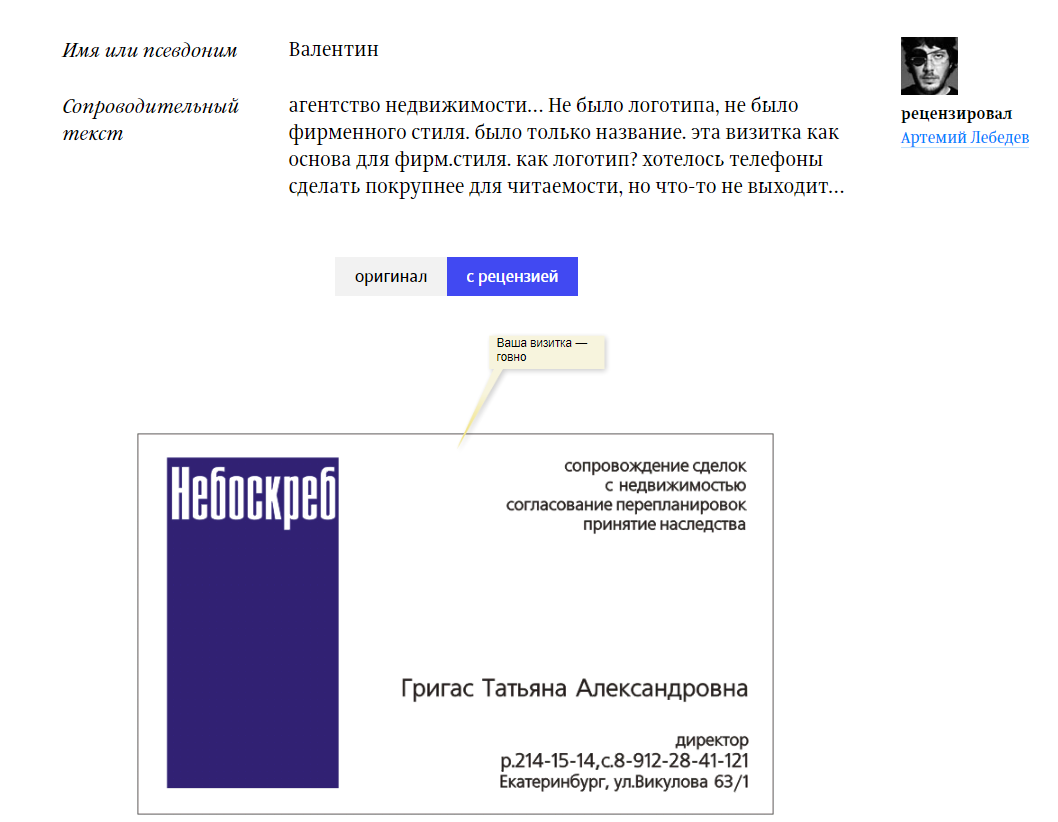
Here is a screenshot of the first issue of a business lynch with a review by Artemy. Link
- Existing technology - business cards with augmented reality (AR). When a smartphone hovers over a business card, video or audio files, photos, texts, descriptions, pages on social networks, etc. can be displayed. At the same time, you can click on all the elements to go. That is, AR makes a business card almost a personal site, plus a wow-effect is guaranteed, and this is an additional point of contact with the person you handed your business card to.
- Interactive paper - business cards on which you can change and supplement information. In addition, they themselves will be a great souvenir and will be able to serve as a data warehouse.
- However, so far this is too expensive and uncomfortable prospect. Well, we can’t help but smile at the phrase “Sorry, the business card has run out, do you have a charge?”
- Holograms are yet another fantastic kind of business cards of the future.
- A touchscreen is already a fully feasible, but expensive way to surprise others.
- Telemetric business cards that communicate not only contacts, but also transmit useful information.
- Biometric business cards are also a rather promising future, but they are more than any other associated with issues of ethics and security.
The cult of business cards in Japan
Business cards deserved special attention in a country with a special business turnover - in Japan.
As in the XX century, and now, a business card there is perceived as a significant document certifying the professionalism of a person. In the land of the rising sun, business cards should be offered and accepted with both hands with a slight bow - as a valuable gift. And putting the handed card in the back pocket of your trousers is the height of disappointment and ignorance.
It was because of this respect for business cards in 1948 that Japan was shocked by a terrible crime. On January 28, a man with a business card from an official of the Ministry of Public Health (a stranger handed to him on occasion) entered the branch of the Imperial Bank in the Shinamachi district of Tokyo and notified 16 visitors and workers about the outbreak of dysentery in the area. He handed the epidemiologist's card to the bank clerks and invited everyone present to drink a few drops of liquid - a medicine to prevent intestinal infection. 12 out of 16 people died: the liquid turned out to be poison of an unknown type. The criminal himself escaped with cash and checks in the amount of 160,000 yen. This was the first massacre in Japan after the Second World War and the disaster of August 1945.
Police later discovered several more crimes committed by an artist named Sadamichi Hirasawa. In all cases, the killer and robber business cards were at the crime scene. The offender was executed, but his case is still surrounded by myths and speculation.
Indeed, a business card (Macy) in Japan is able to open many doors. Everyone has business cards: from a school teacher to the leader of a criminal group. Business cards reflect the status of an employee and are almost an identity card - if you forget yours, they will look at you in disbelief. There is even a separate agency in the country - the Japan Business Card Association.
MyQRcards: the app that deserves your smartphone
When we created the MyQRcards service, we had our own motives, inspired by dozens of conferences and hundreds of contacts. In three words, we were uncomfortable.
Here are the situations that almost everyone has encountered:
- Workers forgot their business cards - this is especially critical when they forgot them in St. Petersburg, and the conference in Moscow or New York. This is the loss of a mass of business contacts and points of contact with the company. Not that the loss of business cards makes a business trip pointless, but 10-15% of potential performance is lost.
- Business cards end at the conference and now the employee awkwardly displays his number and e-mail on paper from a notebook. This is ugly, fraught with fatal typos, well, besides, it also takes time of the interlocutor.
- Business cards did not have time to print or there was a pile of business cards with the old post. For example, we personally saw the manager girl, who, embarrassed, gave business cards from an old job (in another company altogether!) And told everyone that the mobile number was the same. And who wants to remember this? They will write an e-mail and that’s it, the connection is lost.
- There are no business cards in a foreign language.
- A batch of business cards came out of print with errors or in very poor color rendering.
So, we need to solve three important tasks: relevance, updatability on the fly and availability anywhere and anytime. But it seemed to us not so interesting, and since we started the development, we decided to make an application with a bunch of useful features. Eventually:
- individuals can create a simple business card for free and transfer it to other users;
- companies get the opportunity to create very advanced and capacious business cards, go to the administrator’s console, manage business cards (for example, the HR service can add, delete, edit employee data, change the corporate style and description of the company - all changes are uploaded to each employee).
So what did we get?
- The ability to specify in the business card links to social networks and instant messengers, email and phone numbers that will be clickable;
- Ability to indicate brief information about the company and the address of the company on the map;
- Attach a photo of the owner of the business card, as well as the ability to add photographs to the gallery reflecting the activities of the company / examples of work
- Ability to save a business card in phone contacts;
- Ability to brand a QR code of a business card.
In the end, we created a mobile application for iOS and Android . It is simple and intuitive.
- The user creates a business card, indicates all the necessary contact information. One business card with basic functionality is created for free.
- After creating a business card, a QR code is automatically generated. It is available in a mobile application, it can also be printed, used in presentations or conveniently glued to a mobile phone and “shine” wherever possible.
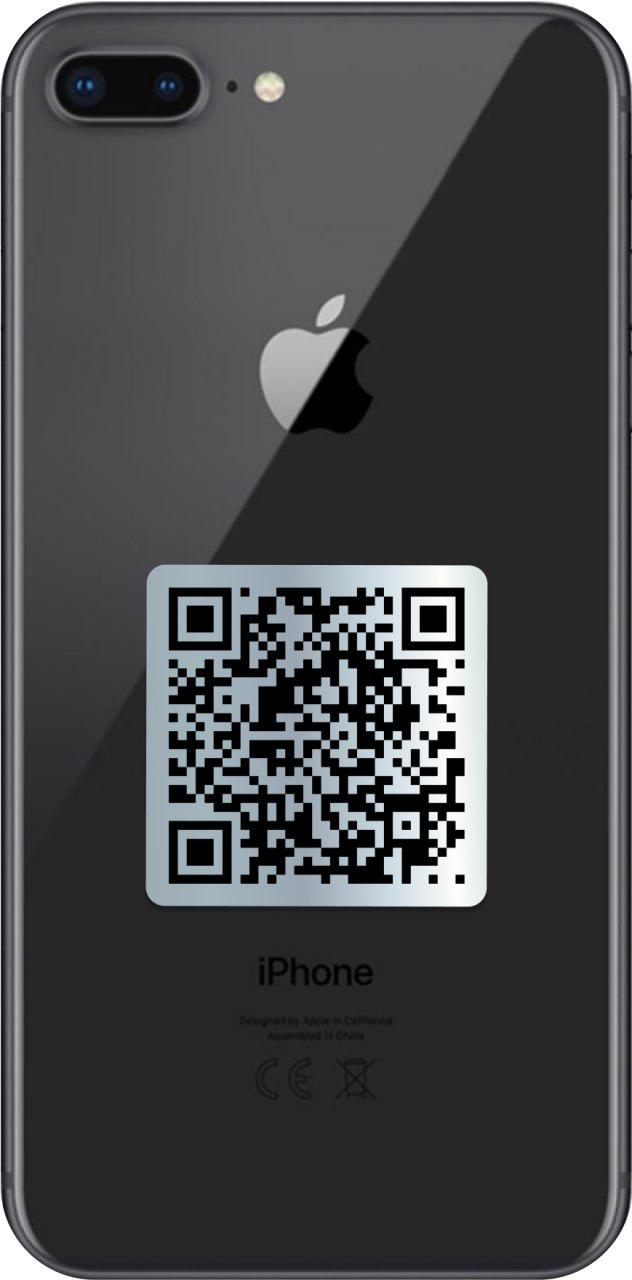
- Scanning a QR code opens the owner’s electronic business card. When editing information in a business card, all changes will automatically be reflected in the old QR code. The one who accepted the business card, the data is stored in the contacts of the smartphone.
A few screenshots - but it's better to download and test it yourself.




Why did companies like this solution?
And I really liked it - MyQRcards are chosen because of its simplicity, convenience, speed of updating information and the ability to add some corporate chips.
- First of all, it is budget savings - the main "trick" for companies that correctly manage their costs. We made an approximate calculation - a company of 100 people saves 50,000 rubles a year, and this is at least a couple of informal meetings with pizza and beer to solve work problems ;-)
- Instant issue - you don’t need to look for an urgent printing typography, wait for an invoice, and then make a payment, write guarantee letters (when this payment doesn’t work out well, but you need to get it yesterday), it’s enough to use official data.
- When changing the position, the circulation does not go to the trash and you do not need to order a new one - just change the necessary information in the interface.
- You can see which of the employees and how actively shared business cards and even make a rating. This is important: so you will know that the employee was not shy in the corner of the conference or meeting, but was actively establishing cooperation (a very useful metric for sales people and project managers).
- Take care of trees - business cards are printed on high quality paper and almost never go into recycling, and this is very bad. Well, business cards made of wood, fashionable in some circles, are generally chaos and wasteful attitude to nature! Be more technological and environmentally friendly, this is the future.
- And yes, it really impresses the partners - once, it takes a little longer (you have a chance to make acquaintance closer) - two, at the first contact you have a topic for discussion (and what kind of business cards are there) - three. For communication is priceless.
Now the development of business cards has been most influenced by mobile technology. And the strategy is clear: the best business card is one that is always on your mobile phone and can be fixed simply and quickly. In the end, we forget mobile phones much less often than business card holders.
Do you think evolution will stop there?
All Articles